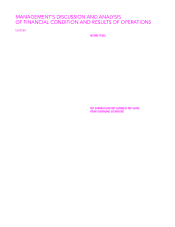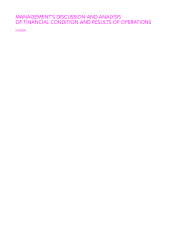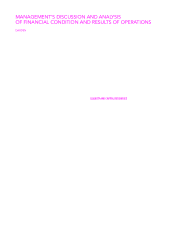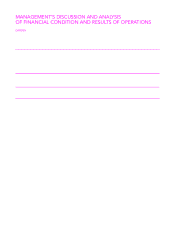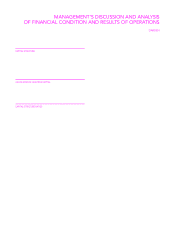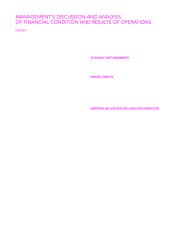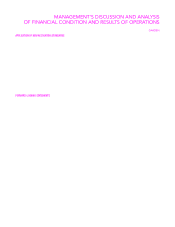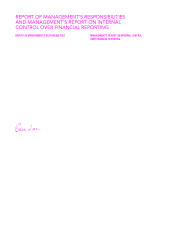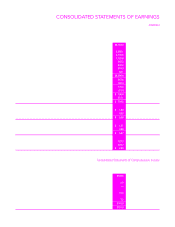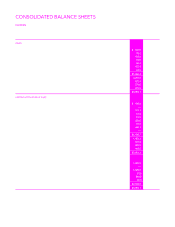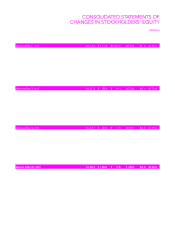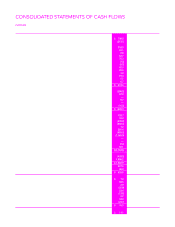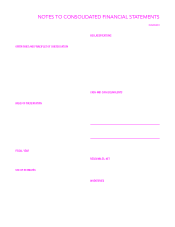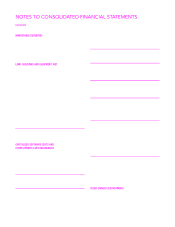Red Lobster 2015 Annual Report Download - page 27
Download and view the complete annual report
Please find page 27 of the 2015 Red Lobster annual report below. You can navigate through the pages in the report by either clicking on the pages listed below, or by using the keyword search tool below to find specific information within the annual report.
DARDEN RESTAURANTS, INC. | 2015 ANNUAL REPORT 23
MANAGEMENT’S DISCUSSION AND ANALYSIS
OF FINANCIAL CONDITION AND RESULTS OF OPERATIONS
DARDEN
APPLICATION OF NEW ACCOUNTING STANDARDS
In May 2014, the FASB issued Accounting Standards Update 2014-09, Revenue
from Contracts with Customers (Topic 606). This update provides a compre-
hensive new revenue recognition model that requires a company to recognize
revenue to depict the transfer of goods or services to a customer at an amount
that reflects the consideration it expects to receive in exchange for those goods
or services. The guidance also requires additional disclosure about the nature,
amount, timing and uncertainty of revenue and cash flows arising from
customer contracts. This update was originally effective for annual and
interim periods beginning after December 15, 2016, which would have
required us to adopt these provisions in the first quarter of fiscal 2018. In
July 2015, the FASB affirmed its proposal for a one-year deferral of the
effective date. Early application is now permitted, but not before the original
effective date. This update permits the use of either the retrospective or
cumulative effect transition method. We are evaluating the effect this
guidance will have on our consolidated financial statements and related
disclosures. We have not yet selected a transition method nor have we
determined the effect of the standard on our ongoing financial reporting.
FORWARD-LOOKING STATEMENTS
Statements set forth in or incorporated into this report regarding the expected
net increase in the number of our restaurants, U.S. same-restaurant sales,
total sales growth, diluted net earnings per share growth, and capital expen-
ditures in fiscal 2016, and all other statements that are not historical facts,
including without limitation statements with respect to the financial condition,
results of operations, plans, objectives, future performance and business of
Darden Restaurants, Inc. and its subsidiaries that are preceded by, followed
by or that include words such as “may,” “will,” “expect,” “intend,” “anticipate,”
“continue,” “estimate,” “project,” “believe,” “plan” or similar expressions, are
forward-looking statements within the meaning of the Private Securities
Litigation Reform Act of 1995 and are included, along with this statement,
for purposes of complying with the safe harbor provisions of that Act. Any
forward-looking statements speak only as of the date on which such statements
are made, and we undertake no obligation to update such statements for any
reason to reflect events or circumstances arising after such date. By their
nature, forward-looking statements involve risks and uncertainties that could
cause actual results to differ materially from those set forth in or implied by
such forward-looking statements. In addition to the risks and uncertainties of
ordinary business obligations, and those described in information incorporated
into this report, the forward-looking statements contained in this report are
subject to the risks and uncertainties described in Part I, Item 1A “Risk Factors”
in our Annual Report on Form 10-K for the year ended May 31, 2015, which
are summarized as follows:
• Our ability to complete our strategic real estate plan, including risks
related to our lease of certain restaurant properties;
• Food safety and food-borne illness concerns throughout the supply chain;
• Litigation, including allegations of illegal, unfair or inconsistent
employment practices;
• Unfavorable publicity, or a failure to respond effectively to
adverse publicity;
• Risks relating to public policy changes and federal, state and local
regulation of our business, including in the areas of environmental
matters, minimum wage, unionization, data privacy, menu labeling,
immigration requirements and taxes;
• Labor and insurance costs;
• Insufficient guest or employee facing technology, or a failure
to maintain a continuous and secure cyber network, free from
material failure, interruption or security breach;
• Our inability or failure to execute a comprehensive business continuity
plan following a major natural disaster such as a hurricane or manmade
disaster, including terrorism;
• Health concerns arising from food-related pandemics, outbreaks of
flu viruses or other diseases;
• Intense competition, or an insufficient focus on competition and the
consumer landscape;
• Our failure to drive both short-term and long-term profitable sales growth
through brand relevance, operating excellence, opening new restaurants
of existing brands and developing or acquiring new dining brands;
• Our plans to expand our smaller brands Bahama Breeze, Seasons 52
and Eddie V’s, and the testing of other new business ventures that
have not yet proven their long-term viability;
• A lack of suitable new restaurant locations or a decline in the quality
of the locations of our current restaurants;
• Higher-than-anticipated costs to open, close, relocate or
remodel restaurants;
• A failure to identify and execute innovative marketing and guest
relationship tactics and ineffective or improper use of social media
or other marketing initiatives;
• A failure to recruit, develop and retain effective leaders or the loss or
shortage of key personnel, or an inability to adequately monitor and
respond to employee dissatisfaction;
• A failure to address cost pressures, including rising costs for
commodities, health care and utilities used by our restaurants,
and a failure to effectively deliver cost management activities
and achieve economies of scale in purchasing;
• The impact of shortages or interruptions in the delivery of food and
other products from third-party vendors and suppliers;
• Adverse weather conditions and natural disasters;
• Volatility in the market value of derivatives we use to hedge
commodity prices;
• Economic and business factors specific to the restaurant industry
and other general macroeconomic factors including energy prices
and interest rates that are largely out of our control;
• Disruptions in the financial markets that may impact consumer
spending patterns, affect the availability and cost of credit and
increase pension plan expenses;
• Risks associated with doing business with franchisees, business
partners and vendors in foreign markets;
• Failure to protect our intellectual property;
• Impairment of the carrying value of our goodwill or other intangible assets;
• A failure of our internal controls over financial reporting and future
changes in accounting standards; and
• An inability or failure to recognize, respond to and effectively manage
the accelerated impact of social media.
Any of the risks described above or elsewhere in this report or our other
filings with the SEC could have a material impact on our business, financial
condition or results of operations. It is not possible to predict or identify all
risk factors. Additional risks and uncertainties not presently known to us or
that we currently believe to be immaterial may also impair our business
operations. Therefore, the above is not intended to be a complete discussion
of all potential risks or uncertainties.



